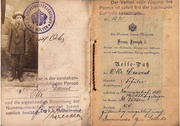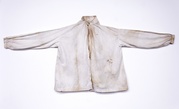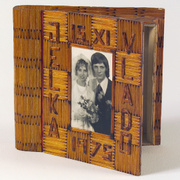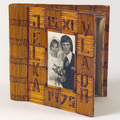
If you were committed to a psychiatric institution, unsure if you’d ever return to the life you knew before, what would you take with you? That sobering question hovers like an apparition over each of the Willard Asylum suitcases. From the 1910s through the 1960s, many patients at the Willard Asylum for the Chronic Insane left suitcases behind when they passed away, with nobody to claim them. Upon the center’s closure in 1995, employees found hundreds of these time capsules stored in a locked attic. Working with the New York State Museum, former Willard staffers were able to preserve the hidden cache of luggage as part of the museum’s permanent collection.
“There were many patients in these asylums who were probably not unlike friends you and I have now.”
Photographer Jon Crispin has long been drawn to the ghostly remains of abandoned psychiatric institutions. After learning of the Willard suitcases, Crispin sought the museum’s permission to document each case and its contents. In 2011, Crispin completed a Kickstarter campaign to fund the first phase of the project, which he recently finished. (Crispin’s current Kickstarter campaign would help him to finish the project entirely.) Next spring, a selection of his photos will accompany the inaugural exhibit at the San Francisco Exploratorium’s new location.
Crispin’s photographs restore a bit of dignity to the individuals who spent their lives within Willard’s walls. Curiously, the identities of these patients are still concealed by the state of New York, denied even to living relatives. Each suitcase offers a glimpse into the life of a unique individual, living in an era when those with mental disorders and disabilities were not only stigmatized but also isolated from society. (All photos by Jon Crispin.)

Thelma’s suitcase.
Collectors Weekly: How did you come across this collection?
Jon Crispin: I’ve worked as a freelance photographer my whole life. In addition to doing work for clients, I’ve always kept my eye out for projects that interest me. In the ’80s, I came across some abandoned insane asylums in New York State, and thought, wow, I’d really like to get in these buildings and photograph them.
So I applied for a grant from the New York State Council on the Arts, got it, and spent a couple of years photographing the interiors and exteriors of these buildings. When the psychiatric programs moved out and shut things down, they basically just closed the doors and walked away. They left all kinds of amazing objects inside these buildings, including patient records in leather-bound volumes.

The exterior of Chapin House, Willard’s central building that was demolished in the 1980s.
In the mid-’90s, I heard that at Willard—one of the asylums in which I spent a lot of time photographing—the employees had saved all the patient suitcases that belonged to people who came to Willard and died there. Starting around 1910, they never threw them out.
“I don’t really care if they were psychotic; I care that this woman did beautiful needlework.”
Craig Williams at the New York State Museum fights an ongoing battle to bring objects like these into the collection, and that’s what happened. Willard was being closed as a psych center and converted to a treatment facility for criminals with drug problems. So the New York State Museum received this collection of suitcases, and displayed a few of the cases in 2004. I asked Craig if I could photograph these things, and he said, “Go right ahead.”

Forgotten band instruments at the Utica state facility.
Collectors Weekly: Why do you think the suitcases survived so well?
Crispin: Willard is this tiny town where multiple generations of people worked in the asylum, like a father would work there and then his daughter would be a nurse there, and so on. I have a theory that the relationship between the patients and the staff was so close, that the staff couldn’t just throw these possessions away when they died. There’s a cemetery on the grounds, and most of these patients were buried right there. And they kept storing their suitcases and moving them around as certain buildings were closed. Then, of course, with de-institutionalization huge numbers of patients were basically turned out onto the street.
Collectors Weekly: Why were the suitcases left untouched for so long?
Crispin: Willard was a facility for people with chronic mental illness. Originally, doctors thought that all you had to do was remove people from the stresses and strains of society, give them a couple of years to get their life together, and they’d get better. Eventually people realized they needed facilities where patients could come and never leave. There’s some question as to whether or not the patients themselves packed their suitcases, or if their families did it for them. But the suitcases sent along with them generally contained whatever the incoming patient wanted or thought they might need.

Clarissa’s suitcase.
Collectors Weekly: What makes you think the patients had access to their suitcases after they arrived?
Crispin: There were many levels of mental illness in these places. Some people were in really bad shape, and sometimes had to be restrained, completely unable to function in any kind of society or environment. Those people probably did not have access to their suitcases.
“It wasn’t some hellhole where people were chained to the walls.”
But a large number of people at the asylum were ambulatory. They were out and about; they worked at the farm; they did artwork. Some of these places even had their own dance bands. The Utica State Hospital had a literary journal. There were many patients in these asylums who were probably not unlike friends you and I have now. The reasons why people were put in these facilities ranged from everything to serious psychoses and delusions to people who couldn’t get over the death of a parent or a spouse. Other people were institutionalized just because they were gay.

Freda’s suitcase.
Initially, my idea was to pair the suitcase photographs with some indication of why these people were in Willard. As the project evolved, I found I wasn’t that interested in such a literal connection. The suitcases themselves tell me everything I want to know about these people. I don’t really care if they were psychotic; I care that this woman did beautiful needlework. I’m much more interested in the objects themselves and what people thought was important to have with them when they were sent away.
Some people at Willard definitely had access to the things they brought with them. For example, one case was filled with what look to be leather-working tools, and it’s pretty clear that this person used those tools because these facilities had time allotted for arts and crafts. The suitcases also contain lots of letters received by people while living at Willard, and there were lots of letters that were written at the asylum but never mailed. There were also examples of things written by people who were obsessive-compulsive, like the guy who wrote down the name of every railroad station in the United States on page after page of his notebooks.

Anna’s suitcase.
Collectors Weekly: Can each suitcase be traced to an individual patient?
Crispin: I have access to all the names, and New York State has the medical records for anyone admitted to these hospitals since the 1850s, so their histories are well-documented. I would like to use their full names in the photographs, but because of the Health Insurance Portability and Accountability Act (HIPAA), the laws about medical records and privacy, there’s some question as to whether or not I could be vulnerable to a lawsuit by the state.

Anna’s suitcase contained an inventory of her glamorous clothing.
Here’s a weird story: When I do the shooting, my digital photographs are labeled with what’s called IPTC information. It’s all the camera metadata stored with each photo, and you can add whatever you want. I typically add my copyright information, and also the names of the Willard patients for my own records. But when I upload photos to my blog, I strip that out.
For one person’s suitcase, I forgot to delete their name. Two days later, I got a call from someone who’s desperate, saying, “Do you have the objects of —?” and she gave the name of the person. And she said, “That is my grandmother. We didn’t know anything about her.” She had Googled her grandmother’s name and came across the Willard suitcases on my site. But even in this situation, the woman had to prove to the state that she was not only the granddaughter of this person, but that she was legally the recipient of her estate. So, in other words, if the grandmother had willed her estate to the other side of the family, this woman would not have been able to get access to her things.

One of Eleanor’s five storage containers.
I’m still trying to figure out how I can name these people, because I think it dehumanizes them even more not to. People who’ve been in mental institutions themselves have said, “Your project is very moving to me, but I’m very disappointed that you have to obscure names.” I think the stigma of mental illness has evolved from something shameful to something that’s much more medical and much more accepted. It just happens to people. But I’ve been very careful at this point in obscuring names, because there are many documents within the cases with names on them. I’m not showing their medical records; I’m only talking about the fact that they lived at Willard.
Collectors Weekly: Why weren’t these suitcases returned to family members when these people died?
Crispin: They tried, and again, the issue had to do with HIPAA laws. Contacting people with the information that their suitcases were in possession of the state was complicated by HIPAA. But the other problem was that a good number of these people were basically abandoned by their families, and their relatives showed very little interest in receiving their things after they died.

A detailed view of Eleanor’s sewing supplies.
Collectors Weekly: What was the process like to shoot the suitcases?
Crispin: Well, when I originally shot the asylums, I would walk into a building or into a room, and I wouldn’t move anything. I prefer being honest in documenting what was already there. But in this situation, you might have a suitcase filled with 30 individually wrapped items that I had to unwrap and position.
The museum had three interns go through every case to catalog the contents and preserve them, essentially taking things that were floating around loose inside the cases, wrapping them, documenting them, and then put them back in the cases. So when I open a case, I’m also recording the way the museum did this, unwrapping the items, photographing them, and then putting it all back.

Crispin also documents the way each item is wrapped and protected by the museum.
It’s a little hard for me because I don’t like to spend a lot of time laying things out, so I basically try to put the objects in a situation that looks as natural as possible. Especially hard were the suitcases filled with clothing. I’m not one of those studio guys who loves to set stuff up and get the lights perfect; I would’ve preferred opening up the case and photographing the inside exactly as I saw it, but that wasn’t possible.

Floyd’s empty suitcase.
There are still empty cases that I haven’t photographed, but even those are interesting to me just as suitcases, and there’s a whole group of people that love old suitcases. I think one of the reasons the project has been so successful is because it appeals to people in very different areas. It appeals to people who had family members in psych centers or who worked in psych centers or who are interested in old Greek-revival architecture. I was posting a lot on my blog, and I got messages from people interested in fabric or needlepoint and ephemera like toothpaste tubes and stuff from the ’20s and ’30s that doesn’t exist anymore.
Collectors Weekly: Was there any single suitcase that stuck with you?
Crispin: One of the last cases I shot was from a guy named Frank who was in the military. His story was particularly sad. He was a black man, and I later found out he was gay. He was eating in a diner and felt that the waiter or waitress disrespected him, and he just went nuts. He completely melted down, smashed some plates, and got arrested. His objects were particularly touching because he had a lot of photo booth pictures of himself and his friends. Frank looks very dapper, and there are all these beautiful women from the ’30s and ’40s in his little photo booth pictures. That really affected me.

Frank’s suitcase included much military-related ephemera.
Dmytre’s suitcase is another that I really like, it’s the last case I did. Dmytre was very moving. He was Ukrainian and clearly brilliant. He had notebooks filled with drawings of sine waves and mathematical things like that. There’s a wedding picture of Dmytre and his wife, and she’s holding a bouquet of fake flowers, which were also in the case.
Dmytre was interesting because he got arrested by the Secret Service because he went to Washington, D.C. and said that he was actually married to President Truman’s daughter, Margaret Truman. And what’s great is there’s a little Washington monument thermometer in the case, so clearly he bought a little tchotchke on his trip to D.C. and then later got arrested for saying that he was Margaret Truman’s husband.

Some of the objects in Frank’s suitcase.
Obviously, some of the cases were a lot more mundane than others. There was one that had syringes in it that were so beautiful and old, and small drug packets with pills still in them. There were combs, books, bibles, clocks, and an incredible Westclox Big Ben alarm clock in its original box that’s unbelievably pristine.
There was lots of expensive stuff, like perfume bottles from Paris that were worth tons of money. People wonder, how is it that a woman who’s committed to Willard has a bottle of perfume, which even at the time was super expensive? Mental illness doesn’t target any one particular group of people; it takes all kinds.

Dmytre’s suitcase contained his wedding photo and the flowers carried by his wife.
Collectors Weekly: Did stories often emerge from the objects you found inside each case?
Crispin: You could tell a lot about a person by what was in their case. One of the most touching letters I read was written to a woman who had been in another asylum and then released and finally sent to Willard. There was a letter from her sister, saying, “You could come back to Erie, but I don’t want you living in the YMCA because they’re still really upset with you for trying to stab that girl.” That one letter tells you a ton about what this woman’s life was like.

Souvenirs and scientific notes found in Dmytre’s suitcase.
But every case was different; I was constantly blown away. It was very important to me not to carelessly rifle through these things and forget that they were somebody’s personal belongings. And I really have a lot of respect for these people as well as the nurses and doctors who worked at the facility. I came away from all of this and the asylum work I did in the ’80s thinking that the state was actually trying to help people. It wasn’t some hellhole where people were chained to the walls. They tried to help, and I think it’s important to keep that in mind.
While I was reverent, I tried not to be overly serious. I actually laughed a lot. If you’re ever around people in psych centers or even psychiatrists and nurses, a lot of their experiences are funny. Some of the items were amusing, but some made your heart ache, and others made you go, holy shit, what is this about? I was constantly affected by the items, and that’s my goal with photographs.

Flora’s trunk.
All photos by Jon Crispin.

 If These Shirts Could Talk: The Tantalizing Tales Behind Used Clothes
If These Shirts Could Talk: The Tantalizing Tales Behind Used Clothes
 The Politics of Prejudice: How Passports Rubber-Stamp Our Indifference to Refugees
The Politics of Prejudice: How Passports Rubber-Stamp Our Indifference to Refugees If These Shirts Could Talk: The Tantalizing Tales Behind Used Clothes
If These Shirts Could Talk: The Tantalizing Tales Behind Used Clothes Love Among the Ruins: Traveling Museum Excavates the Artifacts of Lost Relationships
Love Among the Ruins: Traveling Museum Excavates the Artifacts of Lost Relationships Art PhotographyIt shouldn’t be a surprise that photography became a vehicle for art and op…
Art PhotographyIt shouldn’t be a surprise that photography became a vehicle for art and op… SuitcasesIn 18th-century Europe, leisure travel was only for the rich. Their servant…
SuitcasesIn 18th-century Europe, leisure travel was only for the rich. Their servant… PhotographsFrom Mathew Brady's Civil War photos to Ansel Adams' landscapes to Irving P…
PhotographsFrom Mathew Brady's Civil War photos to Ansel Adams' landscapes to Irving P… Mari Tepper: Laying it on the Line
Mari Tepper: Laying it on the Line Nice Ice: Valerie Hammond on the Genteel Charm of Vintage Canadian Costume Jewelry
Nice Ice: Valerie Hammond on the Genteel Charm of Vintage Canadian Costume Jewelry How Jim Heimann Got Crazy for California Architecture
How Jim Heimann Got Crazy for California Architecture Modernist Man: Jock Peters May Be the Most Influential Architect You've Never Heard Of
Modernist Man: Jock Peters May Be the Most Influential Architect You've Never Heard Of Meet Cute: Were Kokeshi Dolls the Models for Hello Kitty, Pokemon, and Be@rbrick?
Meet Cute: Were Kokeshi Dolls the Models for Hello Kitty, Pokemon, and Be@rbrick? When the King of Comedy Posters Set His Surreal Sights on the World of Rock 'n' Roll
When the King of Comedy Posters Set His Surreal Sights on the World of Rock 'n' Roll How One Artist Makes New Art From Old Coloring Books and Found Photos
How One Artist Makes New Art From Old Coloring Books and Found Photos Say Cheese! How Bad Photography Has Changed Our Definition of Good Pictures
Say Cheese! How Bad Photography Has Changed Our Definition of Good Pictures Middle Earthenware: One Family's Quest to Reclaim Its Place in British Pottery History
Middle Earthenware: One Family's Quest to Reclaim Its Place in British Pottery History Fancy Fowl: How an Evil Sea Captain and a Beloved Queen Made the World Crave KFC
Fancy Fowl: How an Evil Sea Captain and a Beloved Queen Made the World Crave KFC
I wonder if half the patients even knew they had
a suitcase in storage while their mind was detached.
I have come to find that my grandfather’s grandfather Michael Smith (3/31/1825-3/28/1895) was a patient for 6 years per the Supplement to Census 1880- Schedule of defective, dependents and delinquent classes, Troy, Renselear County, NY.
It was said he suffered from Melancholia for 8 1/2 years.
If you have come across anything to share of the time he was there or anything about the man, I would love to add it to my family genealogy narratives.
Thanks for documenting the lives of these poor souls. God bless you!!
Thanks for writing this. I understand how things like this can be personal to some people. And to those who had family hear, good luck finding out information about them! And who knows, Maybe there is a suitcase that shows that someone hear loved horses just a much as I do.
I am working on my family tree and found that the 1940 Census indicates that a great uncle was at the Utica State Hospital. His name was Stanley H King and it would be interesting if information was discovered about him.
My Great Grandmother, Mary Jane McCormick passed away while she was a patient at Willard. I’m wondering if any of her belongings remained behind there.
Clara Wood…
My Great grandmother was a Willard resident 1928-1981 when she passed. How can I access any suitcase or medical record information?
I truly appreciate any help you can offer.
Those committed to an insane asylum in the early 1900s make the line between sanity and insanity clearer for those who glimpsed a bit of both. I discovered in a casual remark by my eldest brother why so may people in my mother’s family were talented musically and very intelligent. My mother’s father was a direct descendant of John Adams. Mother’s father was talented at the ‘fiddle’ and what is now called a ‘fine finish carpenter’ (mantels, ornate bedsteads, tables, etc. for the wealthy) in the early 1930s. It explained for me why so many of my family were smart/talented and some of the self-destructive things my father and uncles did (John Bradshaw wrote a lot about shame and addictions).
In regard to “Jackie,”…you were at Mendocino State Hospital at the time my grandmother was a nurse there. Her name was Erma Knighten, and I believe she worked the night shift in Ward D for many years. Maybe she crossed your path?
I found information on more than a few of their patient’s, including why they were sent there. I don’t like to read unfinished stories, and often to check for truth. Many in the early 1900’s put there had money, veteran, sickly, of course the poor, and even a doctor. If they did not merge another poor home, it may have been a lot better for the patience/worker’s. Names should be given, how many did not know whatever happened to them.
My great-grandmother had patients live in her home while Willard was in the process of being closed down. As a child, I remember going to visit and being so interested in ‘Ma’s Women, as we called them. There were six of them that I remember. I wonder if any of these suitcases were theirs.